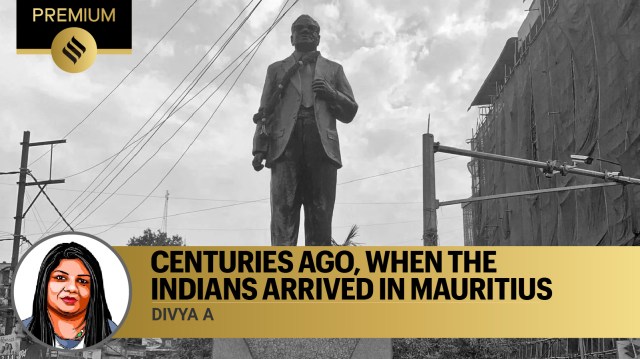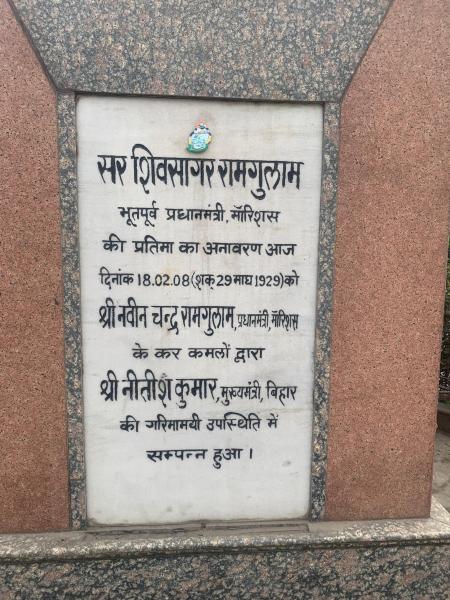Opinion by Divya A
Opinion Centuries ago, when the Indians arrived in Mauritius
While India’s connection with Mauritius dates back nearly 300 years, its link with the island nation’s incumbent Prime Minister — and his father, who was the country’s first Prime Minister — is over 100 years old.
 A life-size bronze statue of Seewoosagur Ramgoolam, the first Prime Minister
of Mauritius, at Patna’s historic Gandhi Maidan. (Photo: Himanshu Harsh)
A life-size bronze statue of Seewoosagur Ramgoolam, the first Prime Minister
of Mauritius, at Patna’s historic Gandhi Maidan. (Photo: Himanshu Harsh) On March 11, Prime Minister Narendra Modi became the first Indian to receive the highest civilian honour in Mauritius — the Grand Commander of the Order of the Star and Key of the Indian Ocean — from the island nation’s Prime Minister Navinchandra Ramgoolam.
While India’s connection with Mauritius dates back nearly 300 years, its link with the island nation’s incumbent Prime Minister — and his father, who was the country’s first Prime Minister — is over 100 years old.
Long before Mahatma Gandhi made a pit stop in Mauritius in 1901, while on his way to India from South Africa, his countrymen had landed on the shores of the island nation in the 1700s itself. During his visit, from October 29, 1901, to November 15, 1901, the Mahatma had three messages for the Indian labourers, mostly from Bihar, residing in the island nation: the importance of education, political empowerment and staying connected with India.
 Bihar Chief Minister Nitish Kumar with Mauritius PM Navinchandra Ramgoolam during the statue inauguration ceremony in Patna in 2008. Express Archive
Bihar Chief Minister Nitish Kumar with Mauritius PM Navinchandra Ramgoolam during the statue inauguration ceremony in Patna in 2008. Express Archive
The first documented arrival of Indians in Mauritius dates back to 1729 — while it was under French occupation — when Indians artisans and masons were sent off to the nation from Puducherry, then a French colony in India.
Between 1834 and the early 1900s, Mauritius was under British occupation. During that time, nearly half a million indentured Indians were shipped there. The first batch of 36 workers arrived there on November 2, 1834, on a ship named Atlas. To this day, November 2 is observed as ‘Aapravasi Diwas’ in Mauritius. About two-thirds of these workers would settle in Mauritius permanently.
But it was the arrival of a teenage Indian immigrant from a family of coolies from Bihar’s Harigaon that would forever change the island’s fortunes. Lured by his elder brother Ramlochun Ramgoolam’s tales about the rosy life in Mauritius — how one could snatch handfuls of gold by just lifting stones —18-year-old Moheeth Ramgoolam was deposited on the nation’s shores in 1896 by a ship named Hindustan.
Having started out as an indentured labourer on the sugar estate of Queen Victoria, Moheeth would rise to the position of a sirdar (overseer). Two years after his arrival, in 1898, Moheeth married Basmati Ramchurn, a young Mauritius-born widow who had two sons with her first husband.
The couple, Moheeth and Basmati, had two daughters, but both did not survive past infancy. Then, on September 18, 1900, Basmati gave birth to Seewoosagur Ramgoolam in Belle Rive. Fondly called Kewal as a child, Seewoosagur, the father of the incumbent Prime Minister, would become the first Prime Minister of Mauritius.
 The statue of Seewoosagur Ramgoolam was inaugurated on February 18, 2008, by his son Navinchandra Ramgoolam, the Prime Minister of Mauritius then too, during his visit to Bihar. (Himanshu Harsh)
The statue of Seewoosagur Ramgoolam was inaugurated on February 18, 2008, by his son Navinchandra Ramgoolam, the Prime Minister of Mauritius then too, during his visit to Bihar. (Himanshu Harsh)
Often referred to as ‘Chacha’, Seewoosagur would remain Prime Minister for years. His years in power included overseeing the country’s emergence as a successful, democratic welfare state. Years later, Moheeth’s grandson Navinchandra, by then the Mauritius Prime Minister, would return to Harigaon in Bihar to trace his roots.
An invitation from then Chief Minister Nitish Kumar saw Navinchandra arrive on a three-day visit to Bihar in February 2008. During this trip, Navinchandra visited Patna, Siwan, Nalanda, Bodh Gaya and Harigaon.
On February 18, 2008, he unveiled a life-size bronze statue of his father in Patna’s Gandhi Maidan, a historic site near the Ganga, besides inaugurating a street in his name. In Harigaon, he laid the foundation for three projects — a lake, a high school and a hospital, named after his grandfather, father and himself, respectively. On behalf of the Government of Mauritius, he pledged a donation of $2,50,000 for Harigaon’s development.
most read
At present, Mauritius has 22,188 Indian nationals and 13,198 Overseas Citizenship of India (OCI) card holders. During President Droupadi Murmu’s state visit to Mauritius in March 2024, in a special gesture, an OCI card for Mauritians with Indian lineage traceable up to the 7th generation was announced.
In 2024, Mauritius introduced a visa-free regime for Indian tourists visiting their country for up to a month. Before Covid, around 80,000 Indian tourists visited Mauritius annually. Mauritians are entitled to a gratis visa (issued without consular fees) during their India visit. Before the pandemic, 30,000 Mauritians visited India each year.
On how he felt about his Bihar visit, Navinchandra had said, “It feels great. It feels even though I have been away from Bihar, it’s like coming home.”
The writer is a Senior Assistant Editor





